Monday, August 7: Leaving Osaka Garden Palace, I walk a half mile in the pouring rain, lugging my suitcase behind me, to Shin-Osaka Station. Last night, I bought an 8:40 a.m. ticket for the Shinkansen, to arrive in Tokyo at 11:13 this morning. Since I get to the station early, I stop at Tully’s Coffee for a breakfast snack and coffee, sharing a table with a British couple traveling around Japan. We have a nice chat about our travels, and then I’m on my way.
All the way on the Shinkansen, news about the typhoon is flashing on the screen at the front of the car. I read on my phone that the worst parts of the storm are behind us, with some flooding and road closures, and I keep hoping that I’ll make it to Tokyo before the typhoon puts the brakes on the trains.
Luckily, I make it to Tokyo right on schedule, where I get on the Yamanote Line at Tokyo Station at 11:23, arriving at Nippori Station at 11:38. There, after some confusion, I take the Keisei Line for another hour to Keisei-Narita Station, where I get off and catch a taxi to my hotel, Ryokan Wakamatsu Honten. Though it’s too early to check in, I leave my bag and head out. By now, it’s about 1:40. I go in search of a restaurant for lunch, finding a nice spot where I order a sushi set meal.
The Ryokan Wakamatsu Honten is directly across the street from Narita’s biggest temple, Naritasan Shinshoji Temple.

Ryokan Wakamatsu Honten
My first piece of business is to withdraw the rest of my money from my Japan Post account, so I head down Omotesando Street in search of an ATM.
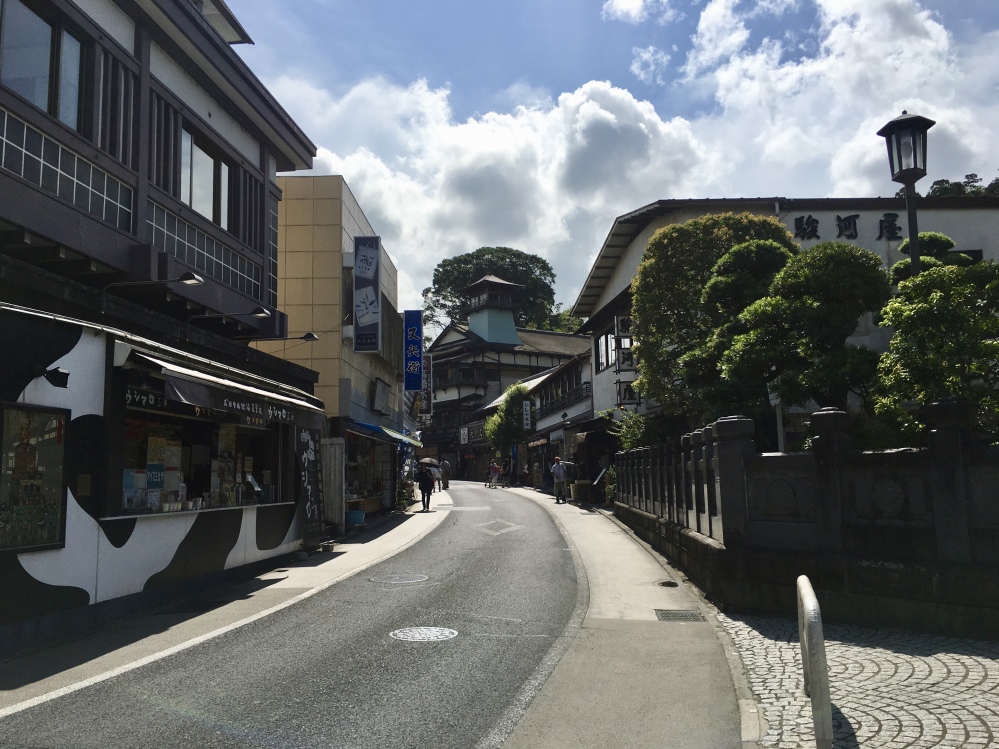
Omotesando Street
After withdrawing all remaining yen from my account, I head to Naritasan Shinshoji Temple, where I admire the impressive 2007 Somon Gate. On the upper story of this main gate, eight different Buddha images representing different birth years are enshrined to protect all people.
Naritasan Shinshoji Temple belongs to the Chisan Sect of Shingon Buddhism. The image of Fudō Myō-ō, “Unmovable Wisdom King,” the main deity of the temple, is historically significant in that Kobo Daishi (or Kukai, the founder of Shingon Buddhism) is said to have carved, consecrated and conducted a Goma ritual before this very statue in 810, by order of the 52nd emperor of Japan, Emperor Saga (786 – 842).
In 939, when a revolt led by Taira no Masakado threw the nation into chaos, the 61st emperor of Japan, Emperor Suzaku (923 – 952), secretly ordered Archbishop Kanjo, a Buddhist priest of the highest order, to carry this Fudō Myō-ō image, which had been enshrined at a temple in Kyoto, to the Kanto area battlefield to suppress the rebellion. Here at Narita, Kanjo conducted a Goma rite in front of the image lasting 21 days, praying for the sake of peace. On February 14, 940, the final day of the Goma prayer, the revolt was suppressed and Naritasan was founded to commemorate the victory.
The temple is famous for its Goma ritual, where many votive offerings are dedicated in front of the Fudō Myō-ō and special wooden Goma sticks are burnt on the altar. The fire of the Goma rite symbolizes the wisdom of Fudō Myō-ō, and the wooden Goma sticks represent the afflictions of human beings. By burning the Goma sticks, which have been inscribed with the human afflictions in the fire of Fudō Myō-ō’s wisdom, the officiating priest prays with the devotees that their afflictions might be removed (from the temple pamphlet).

Somon Gate
The 1831 Niomon Gate enshrines the four guardians of the Buddha-Misshaku-kongo on the right and the Naraen-kongo on the left in the front, and Komoku-ten and Tamon-ten in the back.

walkway to Niomon Gate
As with all Japanese temples, there is a water purification area where visitors should cleanse themselves before entering the temple grounds.

water pavilion
The huge red lantern at Niomon Gate is impressive in its size.

Niomon Gate

Lantern at Nioman Gate
Niomon Gate’s lantern is quite beautiful.

lantern at Niomon Gate
Adjacent to the Niomon Gate is Nio-ike pond, where people can release live fish symbolizing the Buddhist teaching of nonviolence, or the belief in the sacredness of all living creatures. A rock in the pond is covered with a congregation of small turtles.

Pond with turtles around Niomon Gate
There are many halls and buildings on the grounds of Naritasan Shinshoji Temple.
The 1712 Three Storied Pagoda enshrines five Buddhas, and reliefs of 16 Buddhist saints are carved on the inner wooden walls.
The Three Storied Pagoda here has magnificent ornamentation and vivid colors.

Three Storied Pagoda
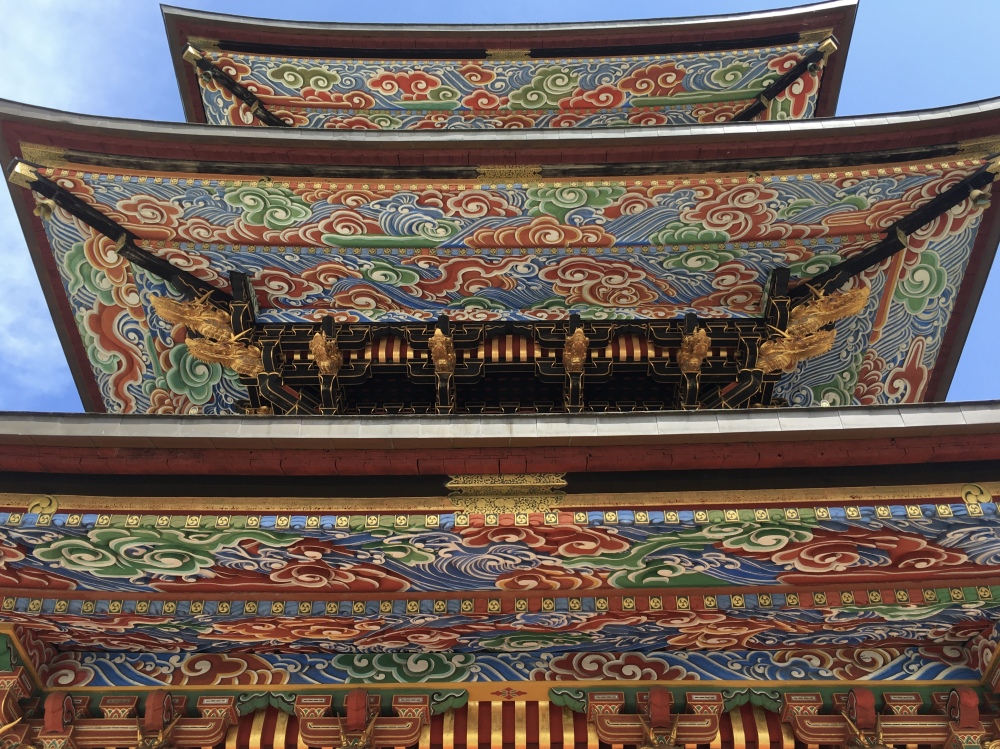
Three Storied Pagoda

Three Storied Pagoda
The Great Main Hall, built in 1968, is where the most important Goma ritual is performed in front of the Fudō Myō-ō image, along with the Four Messengers. I’m lucky enough to attend this ritual as they hold one at 3:00. It goes for about a half hour, with the head priest and other monks chanting and throwing wooden sticks into a fire. It’s miserably hot today, so though the ritual is fascinating, it’s an uncomfortable 30 minutes.

Great Main Hall

Great Main Hall
After the Goma ritual, I go out to explore the rest of the grounds. The Shotoku-taishi-do (or Prince Shotoku Hall) was built in 1992.

Shotoku-taishi-do
Prince Shotoku (572-622 AD) is considered the “Father of Japanese Buddhism.” This hall was erected with the hope of realizing world peace based on the Prince’s ideal: “Harmony should be valued among people.”
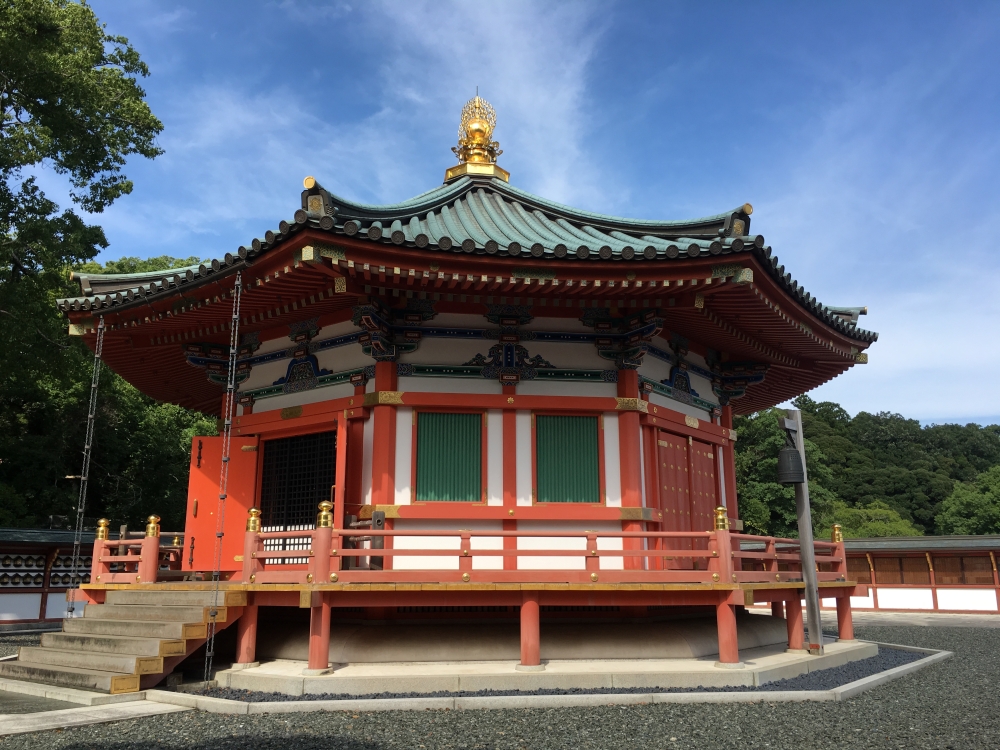
Shotoku-taishi-do
Naritasan Shinshoji Temple of course has its own unique ema.

ema at Naritasan Shinshoji Temple

ema at Naritasan Shinshoji Temple
Shaka-do Hall, built in 1858, was previously used as the main hall. Enshrined within are Sakyamuni Buddha in the center, and four bodhisattvas. The reliefs of 500 Buddhist saints and 24 paragons of Filial Piety are carved in the walls.

Shaka-do Hall

Shaka-do Hall
Shoutendo Hall enshrines the secret Buddha statue of the temple, Daisyo Kangiten. Every first week of the month, a special prayer is performed by a priest. This hall was rebuilt in 2008 as the 1070th anniversary of the temple’s opening.

Shoutendo Hall
Naritasan Park was originally completed in 1928, and redesigned in 1998. It covers some 165,000 square meters. A large pond, waterfall, and fountain enhance the natural beauty of the park.

Naritasan Park

map of Naritasan Park

Naritasan Park
Besides a great array of tombstones in Naritasan Park, the pond has a pavilion and stone lanterns.
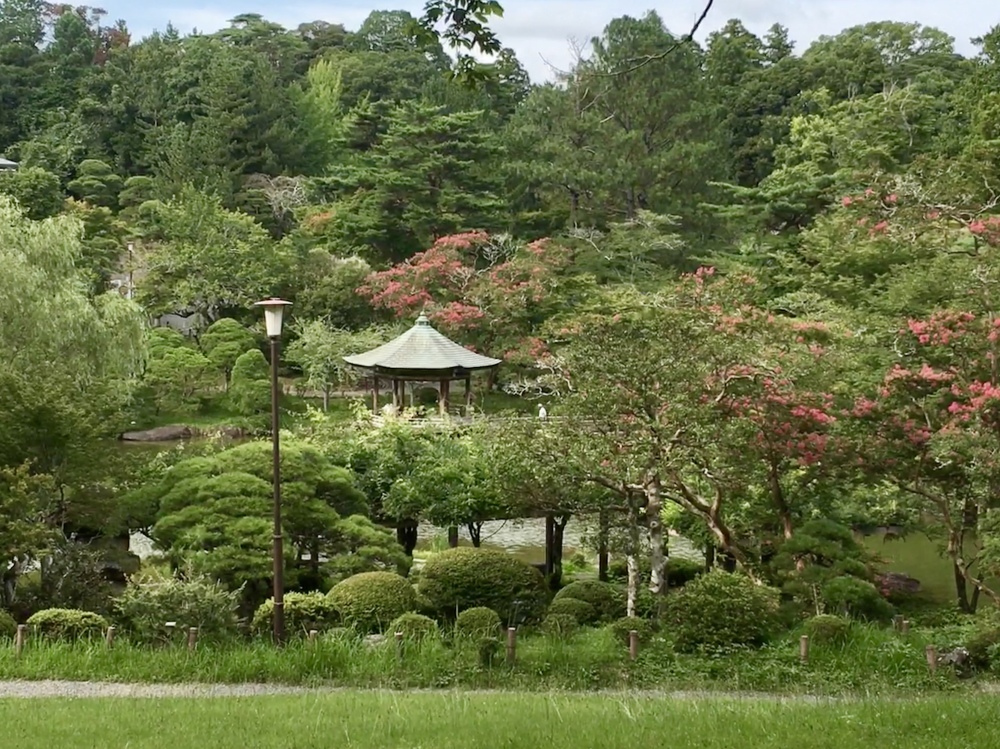
pavilion at Naritasan Park

Naritasan Park

Cool character at Naritasan Park
The Naritasan Museum of Calligraphy is on the grounds of the park, but it is closed by the time I get here.

The Naritasan Museum of Calligraphy
I continue my walk through Naritasan Park, sweating profusely in the heat and humidity.
The 58-meter high Great Pagoda of Peace symbolizes the teaching of Shingon Buddhism. The pagoda enshrines multiple Buddhas and has historical exhibitions about Naritasan, as well as a room for copying the Buddhist scriptures in traditional Japanese calligraphy.
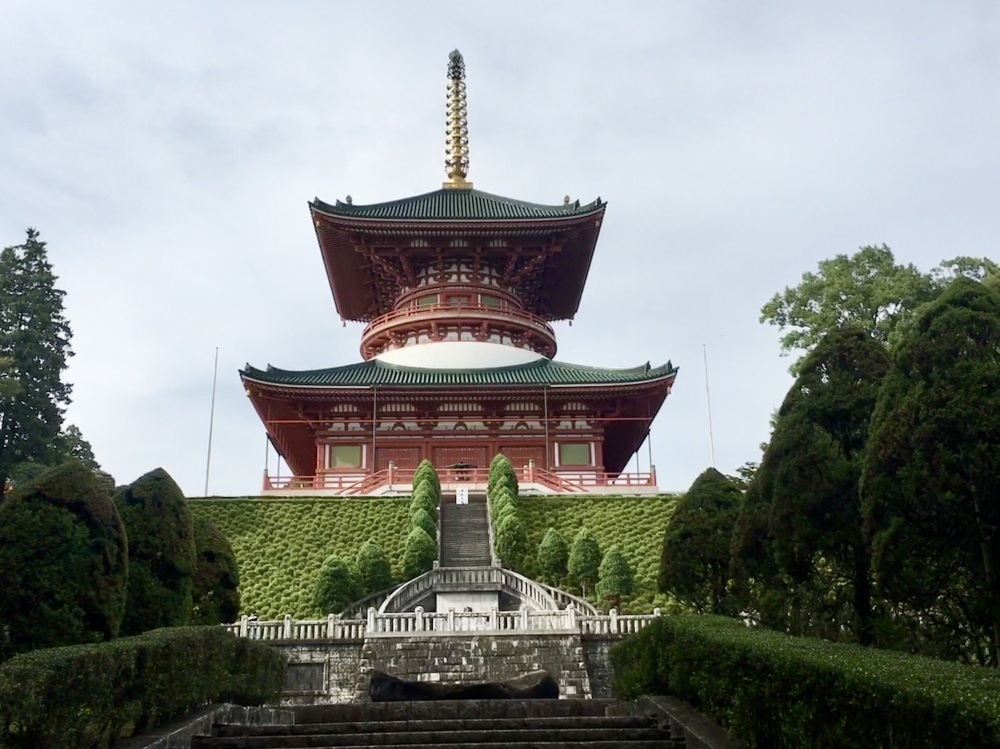
The Great Pagoda of Peace

The Great Pagoda of Peace
Past the Great Pagoda of Peace is a group of other halls, including Seiryu-Gongen-do Hall, originally built in 1732 as the guard of the Naritasan Shinshoji temple. This hall enshrines two guardians, Seiryu Gongen and Myoken.

Seiryu-Gongen-do Hall
Komyo-do Hall, 1701, was originally built as the Main Hall. It is a significant and colorful structure from the middle-Edo period. Enshrined here are Dainichinyorai Buddha in the center, Fudō Myō-ō on the right side, and Aizen-Myō-ō on the left side.
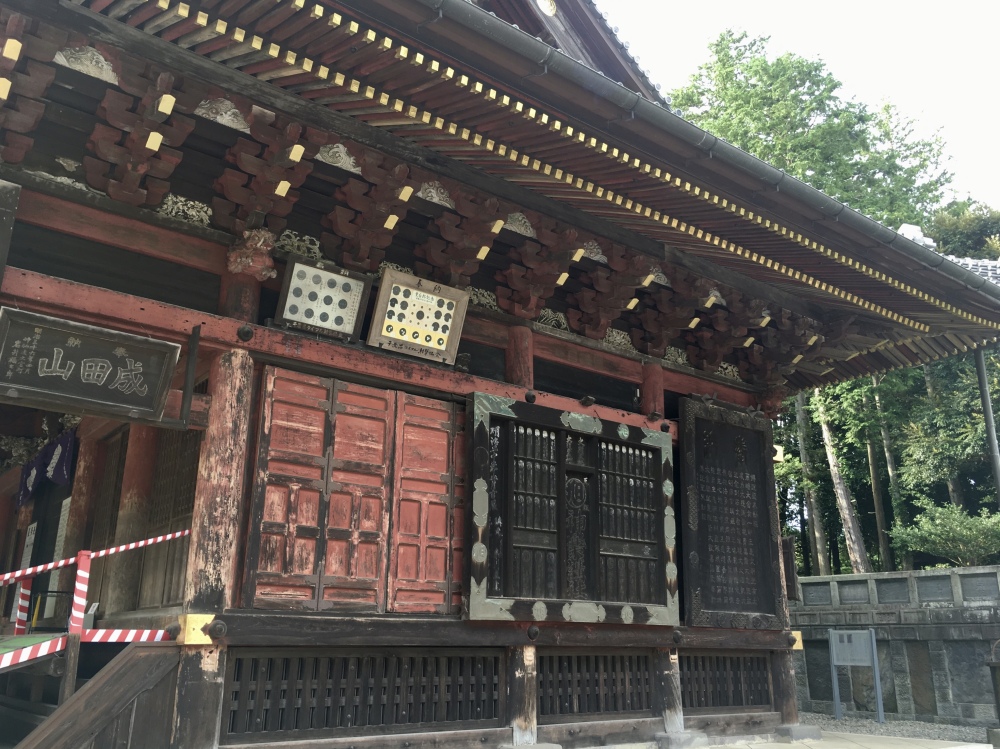
Komyo-do Hall
Okuno-in Cave is 11 meters deep and enshrines Dainichi Nyorai. The door is left open during the Gion Festival from 7th-8th July. One of the stone slabs affixed to the entrance bears an inscription dated 1336.
Sanja Shrine consists of three shrines, which are, from left to right, Hakusan Myojin Shrine, Konpira Daigongen Shrine and Imamiya Shrine.

Sanja Shrine
Kaizando Hall enshrines Kanjo, who founded the Naritasan Shinshoji Temple in 940. The hall was built in 1938 commemorating the 1,000th anniversary of the temple

Kaizando Hall
Gaku-do Hall (1861) displays votive tablets (votive pictures of horses and the like) dedicated by devotees. The Hall contains a large stone image of Ichikawa Danjuro VII (famous kabuki actor) and the “Giant Bronze Globe (built in 1907).”

Gaku-do Hall

Gaku-do Hall
After my long and exhaustive walk around the sprawling temple, I return to my room at Ryokan Wakamatsu Honten, where I relax after soaking in the onsen. It’s nice and cool in my room and it feels good to have the sweat washed away.
My Ryokan is directly across the street from Naritasan Temple and I have an excellent view from my window of Daishi-do Hall and Korinkaku Hall.

view from my window of Daishi-do Hall and Korinkaku Hall at Naritasan Temple
After a while, I go out to search for dinner, stopping first to take a parting shot of the Somon Gate in the blue light.

Somon Gate in blue light

Naritasan
By this time of night, the old town is quite deserted and I have to walk a long way to find an Indian restaurant where I can enjoy a meal.

Omotesando Street

Omotesando Street

Omotesando Street
Tuesday, August 8: In the morning, I take an early taxi to Narita Airport, where I have a 10:40 a.m. flight to Dallas/Fort Worth airport. However, we sit on the runway for over an hour because Alaska’s tiny Bogoslof volcano erupted, sending an ash cloud about 6 miles into the sky. As a “red” aviation warning was issued, we couldn’t take off until a new flight path was charted.
We took off over an hour late, so I knew before we left the ground that it was unlikely I would catch my connecting flight home to Virginia.
After an 11 hour and 45 minute flight, I arrive in Dallas at 9:50 a.m. on the same day, August 8, earlier than I left. I always find this amusing when traveling home from Asia.
However, because of our late departure from Tokyo, by the time I disembark from the plane in Dallas, I’ve missed the boarding time for my connecting flight. It turns out I will get on a later flight to Dulles Airport, a more convenient airport to my Virginia home than BWI, where I was originally scheduled to land.
Because I have extra time to kill in Dallas, I enjoy a Mexican lunch at the airport, as I won’t arrive home until dinnertime.

lunch in Dallas
Finally, after a three-hour and 12 minute flight, I’m back home, and my Japan adventure has come to an end.
It has been a great adventure, a whirlwind really, and I feel a bit despondent that it’s all over. 😦














































